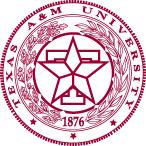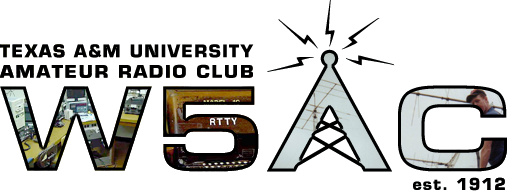

College Station, Texas, U.S.A. • Brazos County • EM10tp


Search:
Callsign lookup:
APRS Locator:
(Type * after callsign for locations that might include a number suffix)
Feb 1, 2003
We had a good number of people show up for our first Saturday Work Meeting of the year. The first thing we did was attempt to tune in the NASA channel on the C-Band dish to keep updated on the Columbia event. However, we were unable to tune in anything with the dish and the receiver didn't have any lights on in the front, like it usually does. This is probably yet another victim of a nearby lightning strike several weeks ago. We haven't determined yet if the problem is with the LNA, the receiver, or both. Mike, KZ5M, said he might be able to contact a former club member who could help us with the satellite receiver. We next attempted to label every incoming coax cable properly and match it to a known antenna on the roof, so we have a good inventory of antennas. There are two antennas on the MSC elevator penthouse that have mysteriously appeared in the past few years and they aren't ours. One appears to be a 70cm or thereabouts vertical and the other is of unknown frequency and is about 12 inches away from our VHF stack tower. The coax for these two antennas enters the building through a fan/vent on top of the penthouse. The HF antennas were checked out for abnormal SWR and we found that the mosely beam was awful, as previously reported by Dennis, KD5KQN. Mike, KZ5M climbed the HF stack tower and cleaned up the connection of the coax to the mosely and now it tunes to less than 1.5:1 on all bands except 20 meters, which has a 1.7:1 SWR. Also on the HF stack is our dual-band 2m/70cm fiberglass vertical which is in splinters because of the lightning. We discussed replacing it with something like a Hustler G6-270R dual-band, like we have for the repeater, because of it's durability and single-piece construction. Since the OSCAR arrays are taken down for rotor repair (and the 440 FM Beam thas was also on that mast), we didn't have any way to get on 70cm, so Gabe, KC5OED, Chris, KD5SYI, and Daniel, KD5UTN removed the discone and replaced it with the 70cm beam, pointed East. This is a temporary move until we have the elevation rotor working again, but it allows us to reach the New Waverly repeater on 442.725 MHz, which is a Saltgrass link. The poor performance of the 40m and 80m dipoles was investigated and the connections were cleaned, but they still have intermittent high SWR. Dick, W5DZ, says they should be replaced, as discussed in our past meeting. Finally, we measured the SWR on all of our antennas: Mosely beam: good SWR all bands. Slightly high (1.7:1) on 20m. R5 vertial: 10m - 1.2:1 12m - 1.3:1 15m - 1.2:1 17m - 1.5:1 20m - 1.2:1 6m beam: 50 MHz - 1.5:1 52 MHz - 1.7:1 53 MHz - 2.5:1 2m horizontally polarized beam - 1.5:1 2m vertically polarized beam - 1.05:1 (very low) 2m vertical on top of VHF stack - 1.05:1 (very low) Also noted was that KANM student radio can be heard on the 6m rig at 50.558 MHz AM. Further investigation should reveal whether this is a problem with our 6m transceiver or if KANM is not transmitting cleanly. --------- Addendum: I wanted to add to the work report list that the 160 Meter Dipole was taken down from the tower. The G5RV solution is excellent for 10-80 meters but will not address 160 meters. 160 meters is a difficult band to work because of the level of static and the length of the antenna that is needed. The old 160 dipole apex was tied to the metal tower with a rope and the elements were not insulated from the metal tower, so rebuilding the 160 dipole as it was is not recommended. We may need to find a better solution for 160 at some point. Mike Mertes - KZ5M
April 3, 2004 - #1 for the semester
Our first spring work meeting turned out to be a good preliminary meeting. Members at the work meeting were KD5NPF, KZ5M, N5TLT, NT5TU, and W5DZ. N5TLT got the KC Tracker working, and it successfully followed a satellite as we watched. However, after one satellite, the KCT software complained that the rotor was "stalled", and now the satellite array elevation rotor (a Kampro KR-500) is frozen in one position. Taking the el. rotor down for repair (again) requires another future work meeting, one that starts early in the morning so that we can take the antennas off the array and remove the rotor before it gets hot (and that roof gets very hot). Also for next work meeting, some of our antenna coax cable is still unlabelled ('til we follow it down from the tower to the shack). Once the elevation rotor works again, talking to satellites will be as easy as running the computer program, flipping on the KCT switch (the box with a fuse on the front), turning on the two rotor indicator boxes and using the satellite station radio to talk to sats as they fly overhead (well, maybe it's not so simple, with Doppler shift and all, but it will work!). W5DZ took down the remains of EGOR and NASA Select rebroadcasting. The two radios used in those operations might have been damaged in the infamous lightning strike, and he is checking them out with his service equipment. If they do still work, the club may have a pair of backup 2 meter radios for future use. The computer part of EGOR makes noises but does not boot. We now have a more clear workspace where EGOR once stood. There is room for future Echolink, Amateur TV, and other equipment work to take place. The Kenwood TS-600 6 meter base station rig apparently works except for the fact that it is deaf. The Kenwood 700 base station seems to have been dead for a while now. The other VHF/UHF radios are good. We did not spend the time today to put back up the 70 cm beam antenna, but the 70 cm radio can be connected to the cable on the EGOR workbench that has a coax extension on it; that connects it to the dual-band vertical antenna on top of one of the towers, though it needs an SWR check before transmitting (note: it later checked out just fine). The nearby Saltgrass-linked repeater isn't even on Saltgrass at the moment anyway, and that was our primary motivation for the beam. It can still go up at the next work meeting (note: Saltgrasas Link is back up as of April 8!). KZ5M showed us an example of the data radios we'll be converting for packet use. N5TLT, when observing the satellite freezing rotor problem, noticed that the control wires that go to the VHF tower stack rotor have extremely ultraviolet-ray-damaged casing. NT5TU mentioned in an earlier e-mail to the listserv that our coax is, in effect, showing its age, and though it works for now, we may do better replacing coax to improve reliability during emergencies. Michael Baur - KD5NPF
April 10, 2004 - #2 for the semester
This was a quick workmeeting to take down the satellite array's elevation rotor. Members at the work meeting were Mike KD5NPF, Bo KD5MLR, Mike KZ5M and Dennis NT5TU. As we took down the antennas and rotor, we temporarily waterproofed the coax connections and labelled them, and recorded the color codes for the wiring that goes to the back of the rotor. The rotor came down fairly quickly (though putting it back up will take longer). Dennis also completed some more repairs on the G5RV. More of our coax was labelled, partly in preparation for putting the rotor back up (along with the 70 cm beam antenna) sometime soon. We found corrosion in the coax of the 70 cm cross-polarized beam antenna on the satellite array, as we took the antennas off the array. The antenna was only recently put back up there after earlier rotor problems. When the antennas go back up, they need dielectric grease added to the coax connections. Also, the same 70 cm antenna needs a counterbalance, or else it will continue to "droop" when the array goes upside down following a satellite. By the way, if you go up the ladder to the VHF tower, watch the slightly-loose rung on that ladder right at the level of the main roof. Some time in the future, we should reinstall the OSCAR preamp for better reception while listening to satellites; it was broken a while ago when accidentally transmitted into (it is receive-only). Along with that, we need to find a solution that doesn't allow transmitted signal to reach that preamp, nor the downconverter on 2.4 GHz (on the barbecue grill antenna). Finally, it'd be nice if we put back up the discone for our scanner; it has a place near the HF tower just waiting for it. Michael Baur - KD5NPF
October 30, 2004 - Disaster Trailer
This work meeting took place Saturday (about 9:30 - 3:00) at Riverside Campus. We did some work on the disaster trailer so that we can both install W5DZ's portable repeater on it and repaint it for future recruiting opportunities (like displaying it at Rudder Fountain). Members at the work meeting were Mike KD5NPF, Kevin KE5CQJ, Mike KZ5M, and Dick W5DZ. We scraped off many layers of old lettering, decals, and rust. We removed the smaller, existing repeater cabinet from the trailer and drilled holes through the concrete "floor". We didn't have to move the crank-up tower over to fit the larger cabinet, though opening the door to the new cabinet all the way may interfere with one of the two rear leveling jacks if the jack is down (like if the tower is already up). The group brushed a coat of white Rustoleum paint on the trailer, which turned out well. The wheels weren't painted, though Dick brushed on some rust treatment to stop the surface rust (which takes 24 hours to cure). To finish it, we can paint the wheel rims maroon (if Rustoleum carries it) and bolt down the new repeater cabinet. We should make a stencil of the club logo and paint that on, as well. Dick has requested that we find a toolbox that we could mount to the trailer (similar to the kind that mounts in the bed of a pickup) to hold trailer gear like coax, power cords, a few tools, tape etc. He also plans to mount a PVC tube to the trailer to stow the VHF/UHF dualband antenna when not in use. (Info from Mike Mertes KZ5M) Michael Baur - KD5NPF